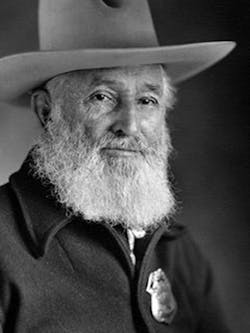Readers of this column have been outstanding in your efforts to point me in the direction of some notable lawmen. This month's Legendary Lawman comes to us from a plentiful source from our country's history, the Texas Rangers.
John Reynolds Hughes was born on February 11, 1855 near Cambridge (Henry County), Illinois, to Thomas and Jennie (Bond) Hughes. Sometime in 1865 the family moved to Dixon, Illinois, where John would attend schools sporadically. The family would later move to Mound City, Kansas.
At the tender age fourteen Hughes left home to work on a neighboring cattle ranch but soon left there for Indian Territory. He would live for four years among the Choctaw and Osage Indians and would eventually move to the Comanche Nation in 1874, near Fort Sill. This would lead to work as a trail driver on the Chisholm Trail and earned him enough money to set himself up with a horse spread near Liberty Hill, Texas.
In May of 1886, Hughes would set out after a band of horse thieves that had been stealing his and his neighbors' horses. Having trailed them for months he would eventually kill several of the men and captured the remaining gang in New Mexico (he returned all the captured horses).
This act brought Hughes to the attention of the Texas Ranger Ira Aten. In July 1887, he helped Ranger Aten track down and kill escaped murderer Judd Roberts. Aten would soon thereafter talk Hughes into enlisting in the Texas Rangers. Aten was another notable Ranger that came up with a way to booby-trap fences to explode when cut... but that's another story. Hughes was sworn in on August 10, 1887. His first assignment was Company D, Frontier Battalion at Camp Wood, along the Texas and Mexico border.
In 1893, when Ranger Captain Frank Jones was ambushed and killed, John Hughes took over as Ranger Captain for that area. Because Jones and his small band of Rangers were mistakenly inside Mexico when the ambush had taken place, there was to be no prosecution of those responsible. However, still working undercover, Ranger Ernest St. Leon supplied a list of names of those known to have taken part in the killing to Captain Jones. Accompanied by a company of Rangers, including Ranger Alonzo Oden, Hughes tracked down and killed all 18 men on the list, either by shooting them or by hanging them.
When the Frontier Battalion was abolished in 1900 Hughes was made a captain in command of Company D in the new Ranger Force. He was later appointed Senior Captain, headquartered in Austin, and on January 31, 1915, having served as a captain and ranger longer than any other man (28 years), he retired from the force. Zane Grey's novel The Lone Star Ranger (1914) is dedicated to Hughes and his Texas Rangers. Hughes is known as one of the "Four Great Captains." The others being John H. Rogers, Bill McDonald and John A. Brooks.
Hughes never married. He spent his later years prospecting and traveling by automobile. He became chairman of the board of directors and largest single stockholder of the Citizens Industrial Bank of Austin but maintained his residence in El Paso. In 1940 he was selected the first recipient of the Certificate of Valor, an award inaugurated to call attention to the bravery of peace officers of the nation. Hughes moved to Austin to live with a niece, and on June 3, 1947, at the age of ninety-two, having lived through two world wars and seeing the frontier come to an end, he took his own life. He was buried in the State Cemetery.

Charles Bennett
Charles Bennett was born in our Nation's Capital and grew up in the Maryland suburbs. Mr. Bennett has been working in all aspects of the publishing industry since the late 1980s primarily in the fields of commercial photography and magazine production. Moving to California in 1992 to attend college resulted in B.F.A and Masters degrees. California also supplied Mr. Bennett with his wife. The two of them are avid sports persons and participate in shooting, scuba diving, surfing, running and bicycling. As a long time hobby Mr. Bennett has studied the legends of American law enforcement which led to his writing these columns.



